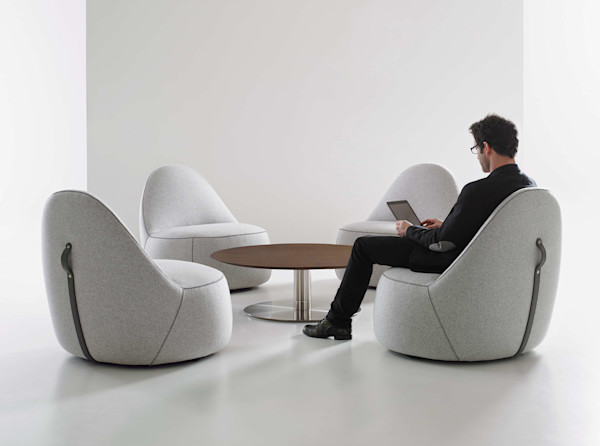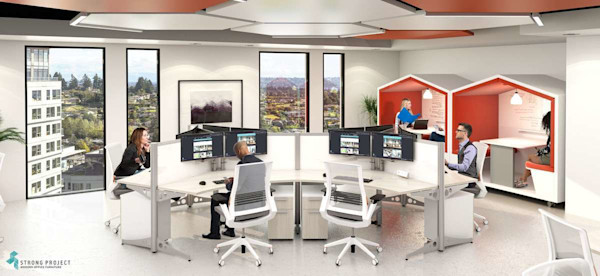A New Level of Employee Well-Being

Updated December 2022 On average, we spend 90,000 hours in our waking lives working. Because of that where we spend that time matters for our overall health. Our environment shapes what habits we form. The choices we make. How well our sleep cycle is regulated and passively influences us through the quality of our surroundings. Because of this, the International WELL Building Institute has created a certification for companies to aspire to achieve, the WELL Certification, which focuses on enhancing health and employee well-being. Much like the LEED Certification which helps maintain high environmental standards, WELL Certification seeks to improve the lives of the workforce. And to make a greater impact on health standards by combining the best practices in design and construction with evidence-based medical and scientific research. The result is the office environment becoming a vehicle for achieving and supporting human health and employee well-being. The qualification process is rigorous, but the certification is a meaningful tool in recruitment, employee satisfaction and retention, and the general well-being of your workforce.
What standards does the WELL Certification regulate?

Air Quality
Air quality is the first feature the WELL Certification considers. And air pollution is the number one environmental cause of premature mortality. The air in your office is of vital importance. WELL Certification considers ventilation design and effectiveness, smoking bans, air filtration, and filtration maintenance, mold reduction, guidelines on pesticide methods, and the building materials and interior décor used in the construction of your office building. This includes the paint on the walls, flooring, and furniture. Purer air minimizes allergens for employees, which lowers absenteeism and helps employees reduce stress and breathe easier in their environment.

Water Quality
Next up is water quality. The human body is comprised of more than two-thirds water, the component of nutrients and waste transport from the body as well as regulating the internal body temperature. WELL Certification test for sediments, microorganisms, metals, pollutants, pesticides, herbicides, and fertilizer, as well as public water additives such as disinfectants and fluoride. The accessibility and taste of drinking water, as well as the maintenance of water faucets and dispensers, is also under scrutiny. This makes the water in an office building an important factor for achieving WELL Certification.

Nourishment and Nutrition Quality
Possibly the greatest of the components measured in WELL Certification is nourishment. What we eat is a key aspect of overall health. While at work, eating healthy is often a challenge. We get busy, so we skip lunch and grab a snack from a vending machine. We may suffer the afternoon slump and snap ourselves out of it with sugar or caffeine.
Make a greater impact on health standards by using the best practices in design and construction.
A WELL-certified office can change that by making available fresh, wholesome foods, limiting unhealthy ingredients, and providing a culture where healthy choices are easier to make than unhealthy ones. WELL-certified offices provide easy access to fruits and vegetables, restrict refined ingredients and ban trans fats. They also label all food choices for allergies, provide full nutritional content on all food items available within the office, and maintain cleanliness standards of all food preparation areas and hand washing stations. Nutritional messaging and advertising are part of producing environmental cues to which people respond. With information about serving sizes, the availability of better choices for those with specialized diets, and participation in sustainable and humane agriculture, people can make better choices. The people who work in a WELL office have at their fingertips the best possible foods for their health. When it comes down to making choices, it’s a no-brainer.

Lighting Quality
The next facet of a WELL Certification is office lighting. The lighting in an office can have a dramatic impact on overall health and employee well-being. The standard addresses how lighting is designed to improve visual acuity, focus, and brightness management through circadian lighting design, glare control, and window shading to minimize solar glare. But the standards don’t stop there. Color quality and surface reflectivity play a role, as does access to sunlight through window size and availability. These regulations improve eyestrain, minimize headaches, and overall affect the mood of the office. An airy, open office space does more for employee health than a cramped, poorly lit office, and not just in terms of productivity.

Fitness Quality and Employee Well-Being
WELL certification looks to improve fitness for employees as well, by integrating physical activity into everyday life through support for an active lifestyle. Regular physical activity is essential for optimal health, improving weight management, the building of immune systems to fight off ailments, and fitness maintenance. Exercise is a way to improve employee well-being. By WELL standards, a building should have easily accessible stairways, incentive programs to promote activity, structured fitness opportunities with physical workout space with quality fitness equipment, pedestrian amenities throughout the office, and active transportation support such as bicycle storage. The furnishings themselves can also help promote activity through the use of sit-stand or treadmill desks.


Emotional and Mental Well-Being
The last, and possibly the most important aspect of WELL Certification is the mind. Our minds and bodies, while often separated medically as individual domains, are inextricably connected. Exercise promotes mood elevation through the release of serotonin. It improves sleep cycles, and reduction of worry and stress, which are all psychological responses. WELL certification includes access to a health and wellness library, learning how interactive design and beauty of the environment impacts employees through post-occupancy surveys, and the adaptation of biophilia in the workplace to bring nature indoors (which has the added bonus of improving air quality). Company health policies are also important in a WELL Certification. For example, policies for business travel, workplace family support, and benefits providing access to stress and addiction treatment. Use thoughtful design supported by medical and scientific research. Transforming the office through WELL Certification will elevate your employees’ health. Show your workforce you care about employee well-being. A company invested in its employees as much as its office is indeed a company on the cutting edge. Design your office for employee well-being with StrongProject.



